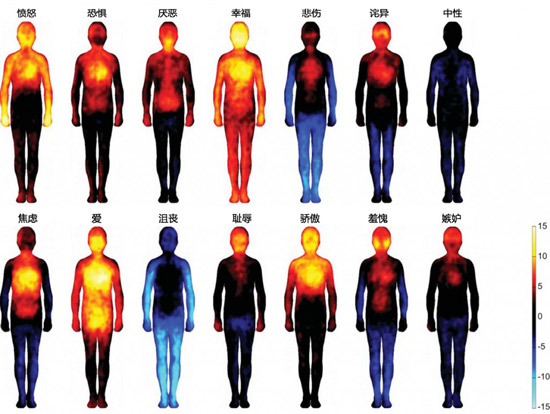当前位置: Language Tips> 双语新闻
Body atlas reveals where we feel happiness and shame

在合成图像中,黄色表示感觉增加的区域,而蓝色表示感觉降低的区域。
|
Chests puffing up with pride — and happiness felt head to toe — are sensations as real as they are universal. And now we can make an atlas of them. Researchers have long known that emotions are connected to a range of physiological changes, from nervous job candidates’ sweaty palms to the racing pulse that results from hearing a strange noise at night. But new research reveals that emotional states are universally associated with certain bodily sensations, regardless of individuals’ culture or language. More than 700 participants in Finland, Sweden and Taiwan participated in experiments aimed at mapping their bodily sensations in connection with specific emotions. Participants viewed emotion-laden words, videos, facial expressions and stories. They then self-reported areas of their bodies that felt different than before they’d viewed the material. By coloring in two computer-generated silhouettes — one to note areas of increased bodily sensation and the second to mark areas of decreased sensation — participants were able to provide researchers with a broad base of data showing both positive and negative bodily responses to different emotions. Researchers found statistically discrete areas for each emotion tested, such as happiness, contempt and love, that were consistent regardless of respondents’ nationality. Afterward, researchers applied controls to reduce the risk that participants may have been biased by sensation-specific phrases common to many languages (such as the English “cold feet” as a metaphor for fear, reluctance or hesitation). The results are published today in theProceedings of the National Academy of Sciences. Although each emotion produced a specific map of bodily sensation, researchers did identify some areas of overlap. Basic emotions, such as anger and fear, caused an increase in sensation in the upper chest area, likely corresponding to increases in pulse and respiration rate. Happiness was the only emotion tested that increased sensation all over the body. The findings enhance researchers’ understanding of how we process emotions. Despite differences in culture and language, it appears our physical experience of feelings is remarkably consistent across different populations. The researchers believe that further development of these bodily sensation maps may one day result in a new way of identifying and treating emotional disorders. |
骄傲感会充满胸膛,幸福感会从头顶灌倒脚底,这种真实的感觉所有人都有体会。而现在我们可以用图谱描绘它们了。 研究人员早就知道情绪影响着一系列体征变化。从求职者因紧张而掌心出汗,到在夜晚听到奇怪的声响而心跳加速。但是新的研究表明,情绪状态与特定的身体感觉有关,无论个人的文化或语言。
(译者:秦丹青 编辑:丹妮) |
上一篇 : 纽约推出天价新年大餐:两人1万美元
下一篇 : 沃尔玛码农薪水高于Facebook软件工程师
关注和订阅


电话:8610-84883645
传真:8610-84883500
Email: languagetips@chinadaily.com.cn